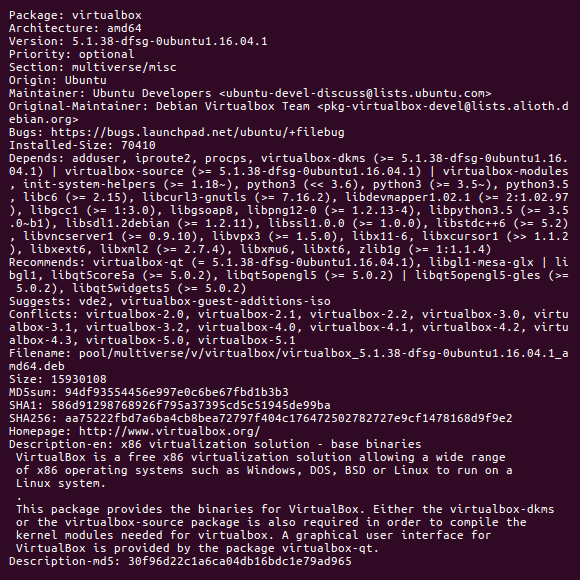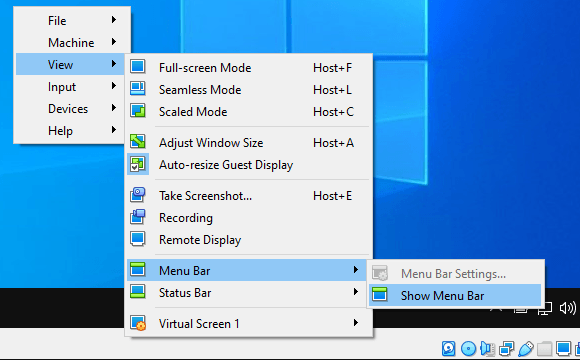In this video, I showed you how to download VirtualBox software 64 bit or 32 bit. You can download this VirtualBox software on Windows, Mac, and Linux OS as. Install Linux Mint VirtualBox – Click New. In the Create Virtual Machine window, enter the name of your virtual machine, select Type as “Linux” and Version as “Other Linux (64-bit).” If you’ve downloaded the 32-bit version of Linux Mint then select “Other Linux (32-bit)”.
Technical Article => Operating System => Linux/Unix
By default, VirtualBox only allows to install 32 bit OS on it. But sometimes, 64 bit OS is wanted for specific uses such as running platform specific tests. To allow installing 64 bit OS on VirtualBox. Below information is needed.
Here is the official documentation about 64 bit OS:
VirtualBox supports 64-bit guest operating systems, even on 32-bit host operating systems, provided that the following conditions are met:

You need a 64-bit processor with hardware virtualization support (see the section called “Hardware vs. software virtualization”).
You must enable hardware virtualization for the particular VM for which you want 64-bit support; software virtualization is not supported for 64-bit VMs.
If you want to use 64-bit guest support on a 32-bit host operating system, you must also select a 64-bit operating system for the particular VM. Since supporting 64 bits on 32-bit hosts incurs additional overhead, VirtualBox only enables this support upon explicit request.
On 64-bit hosts (which typically come with hardware virtualization support), 64-bit guest operating systems are always supported regardless of settings, so you can simply install a 64-bit operating system in the guest.
Warning
On any host, you should enable the I/O APIC for virtual machines that you intend to use in 64-bit mode. This is especially true for 64-bit Windows VMs. See the section called “'Advanced' tab”. In addition, for 64-bit Windows guests, you should make sure that the VM uses the Intel networking device, since there is no 64-bit driver support for the AMD PCNet card; see the section called “Virtual networking hardware”.
If you use the 'Create VM' wizard of the VirtualBox graphical user interface (see the section called “Creating your first virtual machine”), VirtualBox will automatically use the correct settings for each selected 64-bit operating system type.
Based on the documentation, VirtualBox allows to install 64 bit OS even if you have a 32 bit host OS installed. But one necessary condition is that you have a 64 bit processor. The next thing you need to do is to enable hardware virtualization.
You can enable this by going to the BIOS settings, usually when you start your computer, press F12 and then it will go into BIOS mode, there you can find the config setting 'Virtualization Technology' and vt-d feature. By default they are disabled, you need to update them to Enabled. After this, restart the computer and you will see the 64 bit OS option when you create new virtual machine.
One last thing you need to do is to have an 64 bit OS to install on the created VM.
If you don't know how to install OS on VM, you can go to Guide for installing Ubuntu in VirtualBox on Windows.

Tip
To know which CPU you have, on Windows, you can open Control Panel -> System and Security -> System -> Processor.
On Linux, you can use command lscpu.
RELATED
4 COMMENTS
| kaufmanj1973 [Reply] | @ 2015-05-20 20:12:40 |
I am running Windows 8.1 Pro (64 bit) on an Asus laptop, Core i7 processor with 12 gigs of RAM. I have made sure that virtualization is enabled in the BIOS. All is good on that end. Despite this, VirtualBox does NOT allow me to install any 64-bit OS. | |
| Pi Ke [Reply] | @ 2015-05-22 10:21:30 |
I am also using an ASUS laptop with Windows 7(64 bit) installed and it works for me after the BIOS setting. Can you do a check and make sure that no other host apps are using vt-d/AMD-v. such as system level debuggers, other VM platforms and some resident anti-virus applications | |
| Anang [Reply] | @ 2015-10-06 23:17:38 |
| Anderson Bassan [Reply] | @ 2019-04-15 00:45:12 |
Portable-VirtualBox is a free and open source software tool that lets you run any operating system from a usb stick without separate installation.
Installation instructions
See Full List On Linuxvmimages.com
- Download and run Portable-VirtualBox_v5.1.22-Starter_v6.4.10-Win_all.exe.
- Choose a folder to extract to.
- Go to the folder and run Portable-VirtualBox.exe. You'll see a window like the one below:
- If you have already downloaded the installer for VirtualBox from www.virtualbox.org click search and navigate to the file. If not, click 'Download The Installation Files of VirtualBox.' Portable-VirtualBox will show you the download's progress.
- Once the installer is download, check the boxes that are appropriate and click OK. Portable-VirtualBox will extract the files it needs from the VirtualBox installer, and restart itself afterward if you select the last checkbox.
Optional configuration
Portable-VirtualBox makes default settings automatically. You can modify them by pressing CTRL-5 or opening the tray menu while Portable-VirtualBox is running. Either action will bring up the configuration GUI below. The Hokey-Settings tab is shown open in the image below:
Features

- Splash screen to start and end
- Configurable Home Directory
- Launch the VirtualBox GUI or directly launch a VM
- Configure the hotkeys for managing your virtual machine
- Configure USB and network support
- Choose language for GUI
- Saves settings in editable *.ini-files
- Can automatically check for VirtualBox updates
- All absolute paths in the VirtualBox.xml are replaced automatically by relative paths
- Checks to make sure VirtualBox files exist
Install files signature
All install files after launcher version 6.4.10 is digitally signed. Signer is “Open Source Developer, Runar Buvik”, certificate is issued by Certum Level III CA. This is temporarily disabled until a new certificate arrives in the mail.
Note
VirtualBox needs several kernel drivers installed and needs to start several services: if the drivers and services are not already installed you'll need administrator rights to run Portable-VirtualBox.
When Portable-VirtualBox starts, it checks to see if the drivers are installed. If they are not it will install them before running VirtualBox and will remove them afterward. Similarly, Portable-VirtualBox checks to see if the services are running. If not, it will start them and then stop them when it exits.
If you want to save space you can remove the language files for other languages than your own. That can save you nearly 10 MB. They are in the nls directory.
You can also delete the documentation saving nearly 5 MB. You will find it in the doc directory.
Virtualbox Only Shows 32-bit Linux

When the VM is running you must press the 'Host-Key' (initially configured as the right CTRL-Key) to be able to use the other Hotkeys since otherwise the VM will have the focus.
Network support

- To download of Portable-VirtualBox
- Unpack from Portable-VirtualBox
- Start from Portable-VirtualBox
- Attitudes open (Tray --> attitudes, CTRL+5) --> rider Network (Tab) --> VirtualBox with network support start --> memory (save)
- Terminate from Portable-VirtualBox
- Start from Portable-VirtualBox
- Driver installation agree
- Wait
- Selection of a VM and the network map to host interfaces stop
- Attitudes make
- FINISHED
Languages of Launcher
English, German, Portuguese, Spanish, French, Italian, Chinese, Japanese, Polish, Russian and Ukrainian.
Important
None of the files that come from VirtualBox are modified or otherwise changed.
Portable-VirtualBox downloads the VirtualBox installer which contains all of the VirtualBox files and drivers. Portable-VirtualBox unpacks the files and stores them in subdirectories . Portable-Virtualbox can also compress them in order to save space.
Download (M - 0.6 GB / G - 1.6 GB)
[adsense:client=ca-pub-123456,slot=123456,type_ad=head]